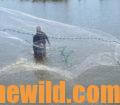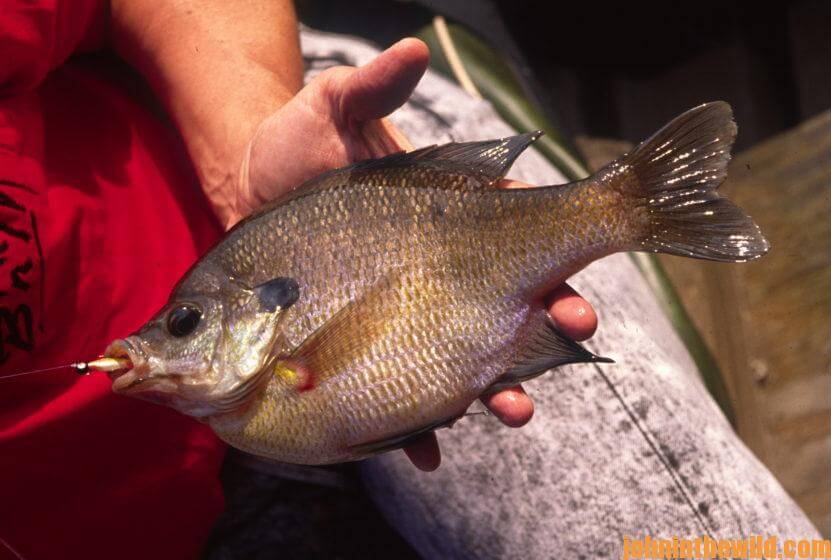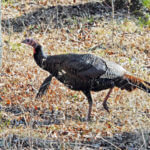Editor’s Note: Most fishermen will name May and June as the main months for catching big bream, which includes bluegills and shellcrackers, and particularly the time around the full moon in May. The bluegill has a black dot on the back part of its dorsal fin with blue cheeks and gill covers. Bluegills primarily eat water insects, inhabit rivers, swamps, ponds and reservoirs and provide fodder for bass. Shellcrackers (also called Redear sunfish) generally grow larger than bluegills and eat snails, small mussels, worms, crickets and bugs with a world’s record of 5 pounds, 7 ounces caught in South Carolina. But, to catch either shellcrackers or bluegills that weigh almost 5 pounds, certain conditions have to come together to produce a new world-record. Just like you can’t take a trophy whitetail, if a trophy whitetail doesn’t live on the property you hunt, the same is true for catching monster-sized bream.
* Utilize GPS Receivers:
Unless you’ve fished Delta Country and other swamps and coastal areas of the U.S. all of your life, you easily can get lost in the many winding fingers, creeks and back-water areas – even with the 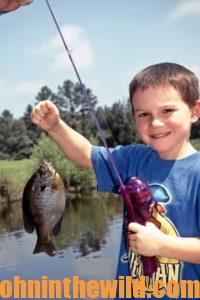 help of a quality map. That’s why you need to use a hand-held GPS receiver to mark the route you take from the boat launch to the spot where you find bluegills. Then, once you locate the fish, save those spots as waypoints on your GPS, and store the route to that place to insure your consistently finding bedding bluegills every year.
help of a quality map. That’s why you need to use a hand-held GPS receiver to mark the route you take from the boat launch to the spot where you find bluegills. Then, once you locate the fish, save those spots as waypoints on your GPS, and store the route to that place to insure your consistently finding bedding bluegills every year.
From the Fourth of July until the first week in September because of the very-hot temperatures, you almost can fry eggs on Alabama sidewalks. Although many people believe the temperatures soar only in the Deep South during the summer months, when I called a friend in New York, he told me, “John, you won’t believe it, but temperatures have reached 90 to 100 degrees here much of the summer.” “How’s the bluegill fishing?” I asked. “Terrible,” he replied. “The fish have abandoned their beds, and nobody can catch panfish up here.” I explained that I planned to fish with another buddy of mine the following week, and that if I discovered how to catch hot-weather bluegills, I’d give him a call. Then he could try what I used to solve his fishing problem.
My friend Ron Smith had invited me to fish a small, shallow pond near his home. When I met him, I looked at the pond and quickly spotted some points coming out into the lake and a few shady coves that surely would hold bluegills. In the 103-degree weather at 2:00 p.m., Smith used his trolling motor to move his boat to the middle of the lake, instead of motoring the boat toward the points and coves. He cast a Beetle Spin (https://www.johnsonfishing.com/), a black-bodied, chartreuse-striped jig.
“The bream hold out here in the middle of the lake,” Smith reported. “The shallow water is so hot, and the sun’s so bright that the coolest, shadiest water in the lake often can be found out here in the middle.” We fished for about 20 minutes before we got a bite. As soon as we caught our first bluegill, we moved the boat to the area where the fish had taken the bait. I marked the spot as a waypoint on my hand-held GPS receiver. Then, I knew Smith and I could return to the same region at any time during the day we wanted to fish it.
Using the trolling motor, we quietly backed away from the site and caught five or six more bluegills holding in the middle of the lake. Each time the fish quit biting, I’d mark the spot as a waypoint.  Then we would move and cast, hoping to locate other schools of big bluegills and shellcrackers. That afternoon, we pinpointed five places in the middle of the small lake where we kept catching 1- to 1-1/2-pound bluegills and shellcrackers. When we finished at our fifth fishing place, we used the GPS receiver to return to our first spot, as a side note we looked into the GPS tracker reviews to find the best one for us, and repeated the same course we had fished earlier that afternoon. At each location, we continued to take big bream until the fish stopped biting. Then we would move to the next waypoint to catch more. During the hottest part of the summer, you’ll locate bluegills schooled-up in deep-water ponds. By finding their schools, you can catch these panfish throughout the day.
Then we would move and cast, hoping to locate other schools of big bluegills and shellcrackers. That afternoon, we pinpointed five places in the middle of the small lake where we kept catching 1- to 1-1/2-pound bluegills and shellcrackers. When we finished at our fifth fishing place, we used the GPS receiver to return to our first spot, as a side note we looked into the GPS tracker reviews to find the best one for us, and repeated the same course we had fished earlier that afternoon. At each location, we continued to take big bream until the fish stopped biting. Then we would move to the next waypoint to catch more. During the hottest part of the summer, you’ll locate bluegills schooled-up in deep-water ponds. By finding their schools, you can catch these panfish throughout the day.
“On slow fishing days when the bluegills refuse to bite, I’ll use a small hook, 4- to 6-pound-test line and two or three live red worms on one hook as bait,” Smith said. “I’ll cast the bait out and let it fall to the bottom. If the bluegills don’t take the worms on the fall, I’ll occasionally twitch the line and mop the bottom with my bait until the bluegills have to attack. I catch big bluegills and shellcrackers using these satellite techniques, even on the hottest days of the summer.”
Many of the best bluegill hot spots never see an angler because most of us have believed that bluegills bed only on the banks. However, I’ve learned if you want to catch this scrappy panfish that fights hard and tastes delicious, learn to fish offshore on deep-water structure, guided by satellite technology.
* Depend on Depth Finders: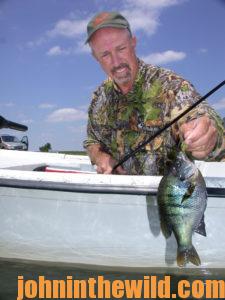
“My buddy caught 20 bluegills that weighed a total of 30 pounds,” avid bream and crappie fisherman Danny Wiles said of David Tucker, as we feasted on bluegills that weighed over 1-pound each. When I asked Tucker where he’d caught bluegills of that size, he answered, “Oak Mountain State Park.” I almost fell out of my chair. Oak Mountain’s two public-fishing lakes are about 15 minutes from my home and 30 minutes from downtown Birmingham in the middle of one of the most heavily-utilized state parks. On almost any weekend, you’ll see from 10 to 50 people fishing these lakes. To obtain heavy weights, bluegills must survive long enough to grow to the older-age classes, which I considered an impossible feat in Oak Mountain State Park’s lakes. “You didn’t catch those bluegills in those lakes,” I told Tucker, who smiled and said, “Meet me out at Oak Mountain. I’ll show you.”
On the appointed day, I showed up with my Zebco ultralight rod and reel with 4-pound-test line. Tucker and I began fishing 50 yards from shore with a small Beetle Spin (https://www.johnsonfishing.com/) jig with a black body and chartreuse stripes. “Let the bait fall all the way to the bottom, and then start a slow retrieve back to the boat,” Tucker instructed. “The biggest bluegills in any pond won’t hold on the bank. They’ll be away from the bank on some type of bottom structure like a ledge, a hump, a drop-off or a point. When you locate bottom structure, you’ll find big bluegills.” Tucker uses a portable depth finder to pinpoint structure on new lakes. He cruises the middle of a lake looking for bottom breaks. Often if you locate a hump or a mound out in the middle of a lake, the bream will bed on top of the mound. Once he finds these mounds, drop-offs or ledges, Tucker marks them as waypoints. Then, every year he can return to these same lakes and use his GPS receiver to locate bedding bluegills.
T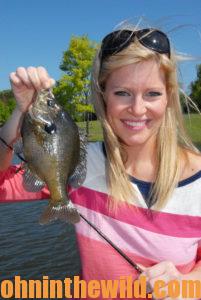 ucker also has pinpointed a honeyhole in Lake Purdy just off Highway 280, a public-fishing lake less than 30 minutes from the downtown area where the city of Birmingham gets a portion of its water supply. Thousands of anglers fish this lake each year, primarily from the bank or from small aluminum johnboats they can rent at the lake. “I’ve found an underwater hump near the dam that comes up to within 6 feet of the surface,” Tucker reported. “Thirty-foot-deep water surrounds this hump. During the summer months, giant bluegills will bed on top of that hump and stay there until fall.”
ucker also has pinpointed a honeyhole in Lake Purdy just off Highway 280, a public-fishing lake less than 30 minutes from the downtown area where the city of Birmingham gets a portion of its water supply. Thousands of anglers fish this lake each year, primarily from the bank or from small aluminum johnboats they can rent at the lake. “I’ve found an underwater hump near the dam that comes up to within 6 feet of the surface,” Tucker reported. “Thirty-foot-deep water surrounds this hump. During the summer months, giant bluegills will bed on top of that hump and stay there until fall.”
Few other bluegill fishermen will put their boats in 30 feet of water and expect to find bluegills. However, since Tucker’s discovered the hump, he’s located a bluegill hot spot that few anglers have fished and has caught some of the biggest bluegills in the lake there. He never forgets where to fish by identifying the area with his depth finder and GPS.
With an ice chest full of bluegills and shellcrackers in my trunk, I headed home to call my friend in New York. When I described the methods we’d used to fish in the middle of the lake to locate the schools of bluegills with a depth finder, record the spots where we’d found the bluegills on my GPS receiver and alternate between those several sites to catch bluegills all afternoon, my buddy planned to test the tactic on the Yankee gills. Two nights later, my phone rang. “I’m the hero of my neighborhood,” my buddy announced triumphantly. “We fished in the middle of a pond, used your depth finder and GPS tactics and caught limits of bluegills for two days. My fishing buddy and I just had a fish-fry for everyone in the neighborhood. He thinks I’m brilliant, and my wife thinks I’m great because I j ust fed all our neighbors.”
ust fed all our neighbors.”
To learn more about bluegill fishing, check out John E. Phillips’ book, “Reelfoot Lake: How to Fish for Crappie, Bass, Bluegills and Catfish & Hunt for Ducks,” at http://amzn.to/XNVVKw, available in paperback.


